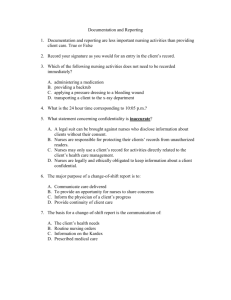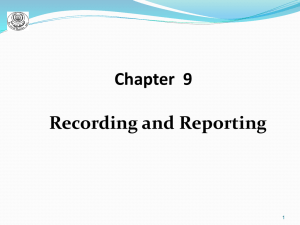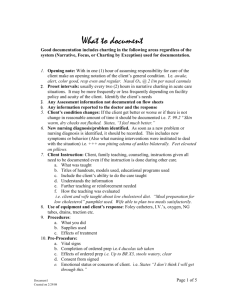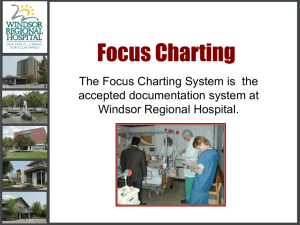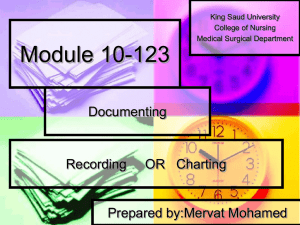documentation - Nursing Students SiteHealing Group
advertisement
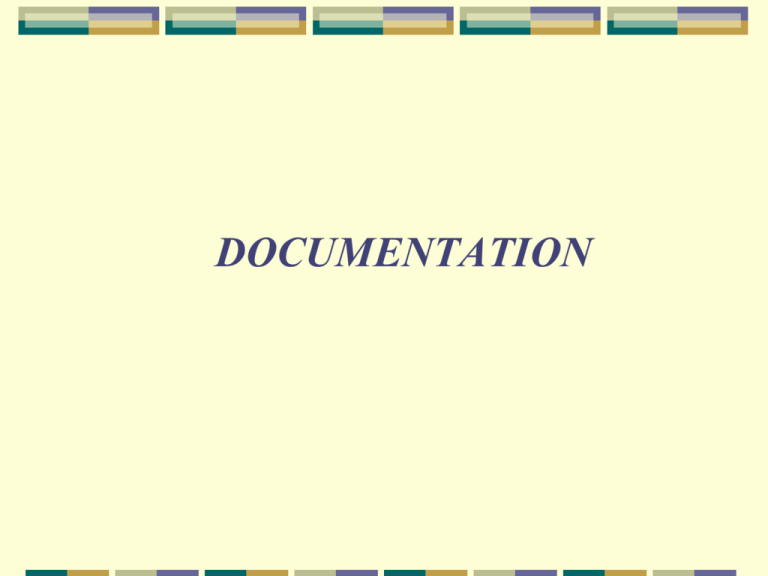
DOCUMENTATION Documentation If it is not charted, it wasn’t done!!! Documentation The written or printed legal record of all pertinent interactions with the client. It reflects quality of care and accountability in providing care. Health personal communicate through: • Discussion • Reports • Records Documentation A discussion: informal oral consideration of a subject by 2 or more health care personnel to ID problem or establish strategies to resolve a problem A report: is oral, written or computer based communication intended to convey information to others (endorsement). A record (chart or client record): is a formal, legal document that provides evidence of a client’s care. Can be written or computer based. The process of making entry on a client record is called recording, charting, or documenting. Documentation Purposes Communication Planning client care: uses data from the client records to plan care Auditing heath agencies: review of client records for quality assurance purpose Research: data can be valuable resource for research Education: Students often use client records as educational tools Legal Documentation: used in the court as evidence Reimbursement: for obtaining payment through medicare, the client’s record must contain the correct diagnosis-related group codes and reveal that the appropriate care has been given Health care analysis: to ID health care agency needs, ID services that cost money and those that generate revenue Documentation Systems I. SOURCE ORIENTED RECORD The traditional client record and organized by discipline Each person or department makes notations in a separate section or sections of the client’s chart (Admission departments have their own sheet, physicians have their own sheets, nurses have their own sheets…etc) Advantage: easy to locate discipline specific information Disadvantage: not organized by client problem, therefore difficult to track; fragmented and have repetition in the information which decreases communication among health care team, an incomplete picture of the client’s care, and lack of coordination of care Narrative Charting: A traditional part of the source oriented record Consists of written notes that include routine care, normal findings, and client problems There is no right or wrong order to the information (may used in emergency situations), chronological order is used frequently ….. II. PROBLEM ORIENTED MEDICAL RECORDS (POMR): Documentation organized around client problems rather than the source of information all disciplines record on same form Advantage: encourages collaboration, and the problem list in the front of the chart alerts care givers to the client’s needs and makes it easier to track the status of each problem Disadvantages: caregivers differ in their ability to use the required charting format, it takes constant awareness to maintain an up to date problem list, and it is somewhat inefficient because assessments and interventions that apply to more than one problem must be repeated. Components: Database, problem list, Plan of care, and progress note Data base: contains all information known about client when the client 1st enters the health care agency, updated according to change in health status Problem list: derived from the data base, problems are listed in order in which they are identified, redefined as patient condition changed or more data obtained Plan of care: made with reference to active problem list, it generated by the person who lists the problem, listed under each problem in progress note Progress notes: Is a chart entry made by all heath professionals involved in a client’s care All use same type of sheet for notes Numbered to correspond to the problems on the problem list SOAP format is frequently used. SOAP/SOAPIE/SOAPIER / APIE/ APIERformat: Subjective data Objective data Assessment Plan Intervention Evaluation Revision III. PIE: Groups information into three categories Consist of flow sheet (assessment) and progress note. Acronym for: Problem: Intervention Evaluation NANDA used to word the problem The problem statement, intervention and evaluation where numbered the same Advantage: eliminate traditional CP and incorporates an ongoing care plan Disadvantage: all nursing note should be reviewed before giving care to determine which problems are current and which intervention were effective. IV. Focus Charting: It intended to make the client and client concerns and strengths the focus of care. Three columns for recording are usually used: date and time, focus, and progress note Focus may be a condition, nursing diagnosis, a behavior, or S/S, client strength The progress notes are organized into: DAR D: Data: assessment phase A: Action: planning and implementation R: Response: evaluation phase Summary of focus charting Date\time Focus - Condition - Nsg Dx - S&S 21/10 9:00 pain progress note - Data: S&O data - Action: P&I - Response: E D: abd. Incision, facial grimacing. Rates pain at 8 on scale 0-10 A: administer morphine sulfate 4 mg IV R: Rates pain at 1. states welling to ambulate V. Charting by Exception (CBE): 1. 2. 3. • Is a documentation system in which only abnormal or significant findings or exceptions to norms are recorded Flow sheets: as graphic records, fluid balance records, daily nursing assessment record, skin assessment record Standards of nursing care: eliminates much of the repetitive charting of routine care. Bedside access to chart form: all flow sheets are kept at the client’s bed side to allow immediate recording and to eliminate the need to transcribe data from the nurse’s worksheet to the permanent record. Advantage: is the elimination of lengthy, repetitive notes and it makes client changes in condition more obvious. VI. Computerized Documentation: Used to store clients database, add data, create and revise CP, and document client progress It make care planning and documentation easy It made transmission of information from one care setting to another possible. VII. Case Management: Uses multidisciplinary approach to planning and documenting client care, using critical pathway Id the outcome that certain groups of client are expected to achieve on each day of care It uses critical pathway, graphics and flow sheet Promote collaboration and teamwork among caregiver, helps decrease length of stay, make efficient use of time Work for client with one or two diagnosis and few needs. Client with multiple diagnosis difficult to document on critical pathway. Documenting Nursing Activities Admission Nursing Assessment Nursing Care Plans Kardexes Flow Sheets Progress Notes Nursing Discharge\referral General Guideline for Recording Date and Time Timing Legibility Permanence Accepted Terminology Correct Spelling Signature Accuracy Sequence Appropriateness Completeness Conciseness Legal prudence Documentation Correcting errors in charting: Single line through error Write “error” above entry Date, time and initial “errored” entry Reporting Purpose: to communicate specific information to a person or group of people. Should be concise, include pertinent information no extraneous details Include change of shift report, telephone report, care plan conference, and nursing round. Change of shift report Is a report given to all nurses on the next shift Purpose: provide continuity of care for pt May be written or given orally (face to face or by audiotape record) Sometimes given at the bedside, where client and nurse participate in information change. Telephone Report The nurse receive telephone report should document the date &time, the person name giving the information, the subject of information, then sign the notation. information should repeated back to the sender to ensure accuracy Be concise and accurate, begin with name and relationship to the client It include (pt name, medical diagnosis, V\S, significant lab data), keep the pt record available to give Dr any additional information After reporting, the nurse document the date and time, call content. Telephone Orders Physician states prescribed therapy over the phone to the registered nurse TO transcribe to the physician order sheet, indicate as VO or TO Then the order should be signed by the physician in a period of time (24hr’s) Include the following information: Date & time orders accepted Stated order Signature & credentials of the nurse Name of the ordering physician - Care Plan Conference: Meeting of a group of nurses to discuss possible solutions to certain problems of a client Nursing Round: procedure in which 2 or more nurses visit selected clients at bedside to : Obtain information that help in Nsg CP Provide chance for the client to discuss their care Evaluate nursing care received to pt






